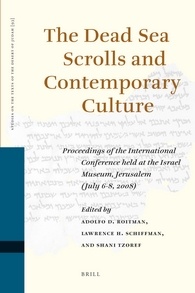Review of The Dead Sea Scrolls and Contemporary Culture
 Ariel Feldman
Ariel Feldman
Brite Divinity School, Texas Christian University
Dead Sea Discoveries 21 (2014) 82–129
Adolfo D. Roitman, Lawrence H. Schiffman and Shani Tzoref (eds.)
The Dead Sea Scrolls and Contemporary Culture: Proceedings of the International Conference Held at the Israel Museum, Jerusalem (July 6–8, 2008). STDJ 93. Leiden: Brill, 2011. Hardcover. Pp. xviii + 769. € 202.00/US$ 287.00. ISBN 978-90-04-18593-7.
These proceedings of a 2008 Jerusalem conference contain 34 essays divided into five rubrics. The volume opens with “Some Thoughts at the Close of the Discoveries in the Judaean Desert Publication Project” by E. Tov. The next four essays deal with the “Identity and History of the Community.” F. García Martínez revisits “The Groningen Hypothesis,” affirming its assumption that the sectarian scrolls reflect different stages in the development of the community.
In her “1QS 6:2c–4a—Satellites or Precursors of the Yaḥad?” C. Hempel suggests that 1QS 6:2c–4a portrays the basic unit of the movement. E. Regev in “What Kind of Sect Was the Yaḥad?” analyzes the parallels between the Yaḥad and some modern sects. J.C. VanderKam, writing on “The Pre-History of the Qumran Community with a Reassessment of CD 1:5–11,” studies the references to 390 and 20 years in the Damascus Document and argues against the Groningen Hypothesis’ claim that D reflects a split from a parental community.
The section on “The Qumran Library” opens with an essay by J. Ben-Dov, “The Elohistic Psalter and the Writing of Divine Names at Qumran,” suggesting that the so-called Elohistic Psalter can be traced back to a single scroll that substitutes Elohim for the Tetragrammaton. P.W. Flint’s “Non-Masoretic Variant Readings in the Hebrew University Isaiah Scroll (1QIsab) and the Text to be Translated” draws readers’ attention to cases where 1QIsab differs from the MT. E. Ulrich reviews how the scrolls offer a “Clearer Insight into the Development of the Bible.” Perspectives on the past and future of the study of biblical interpretation in the scrolls are provided in M.J. Bernstein’s “Biblical Interpretation in the Dead Sea Scrolls.” J.H. Charlesworth in “Revelation and Perspicacity in Qumran Hermeneutics?” reflects upon unique features of Qumran biblical interpretation.
The essay “The Genesis Apocryphon: A Chain of Traditions” by E. Eshel suggests that this composition comprises three cycles featuring Enoch, Noah, and Abraham, with Lamech and Shem serving as “secondary characters” that connect the major three. A. Lange in “From Paratext to Commentary” argues that the terms “parabiblical” and “parascriptural” should be replaced with “paratext” and its derivatives. In “Enochic Judaism: An Assessment” J.J. Collins rejects the Enochic Judaism hypothesis and suggests that Qumran sectarians were fed by diverse traditions. D. Dimant in “Between Qumran Sectarian and Non-Sectarian Texts: The Case of Belial and Mastema” points out that the figure of Belial is mostly attested in the sectarian texts, while Mastema occurs only in a small group of non-sectarian writings. In his “Which is Older, Jubilees or the Genesis Apocryphon?” J. Kugel offers exegetical evidence to support the claim that the Genesis Apocryphon is informed by Jubilees.
“Pseudepigraphy and First Person Discourse in the Dead Sea Documents” by L. Stuckenbruck explores the use of first person discourse in literature attributed to ancient figures. H.K. Harrington’s “Ritual Purity” discusses, among other things, the contribution of the scrolls to the study of purity in early Christianity and rabbinic Judaism. J. Magness in “Dogs and Chickens at Qumran” asks whether some recently uncovered poultry and gazelle bones from Khirbet Qumran may reflect a shift in the community’s halakha. In “Creative Interpretation and Integrative Interpretation in Qumran” V. Noam offers examples of מדרש יוצר and מדרש מקיים in the legal texts from Qumran. C. Werman in “The Price of Mediation” reconstructs a halakhic dispute between the priestly and the early Pharisaic halakha over the issue of mediation and intercession.
In the section on “Christianity in Light of the Dead Sea Scrolls” G.J. Brooke (“From Jesus to the Early Christian Communities”) suggests a four-stage model of Jewish and Christian sectarianism allowing for a fruitful comparison between the parallel modes of development in both traditions. I. Knohl in “The Gabriel Revelation” provides a detailed analysis of the inscription. The essay “Nascent Christianity Between Sectarian and Broader Judaism” by S. Ruzer features two instances in which the New Testament exhibits “broader Jewish or, alternatively, sectarian patterns of religious discourse” (492).
Under the rubric “Gender at Qumran” M.L. Grossman (“Rethinking Gender in the Community Rule”) applies to 1QS and CD tools borrowed from the field of gender studies. T. Ilan’s article, “Canonization and Gender in Qumran,” argues that 4Q179 could have been used by the editor of Lamentations, 4Q184 is contemporary with or inspired by Proverbs, and 2Q18 and 11QPsalmsa 21 indicate that the Qumranites were interested only in the poem embedded in Ben Sira 51, and not in the book of Ben Sira in general. L.H. Schiffman in “Laws Pertaining to Women and Sexuality in the Early Stratum of the Damascus Document” examines those laws in light of the rabbinic halakha. The essay “Women in the Dead Sea Scrolls” by E. Schuller offers an overview of previous scholarship on this topic and points out new directions for future study.
A. Shemesh in “Marriage and Marital Life in the Dead Sea Scrolls” deals with the regulations pertaining to matchmaking, weddings and married life. The concluding section, “New Perspectives,” features an essay by A.I. Baumgarten (“Karaites, Qumran, the Calendar, and Beyond”) examining the impact of different calendric systems on medieval Jewish society as a model for understanding the Second Temple sectarianism. Some reflections on how the scrolls influenced the Reform Movement are offered by R. Freund in “The Dead Sea Scrolls, Hebrew Union College, and Reform Judaism 1948–2008.”

Leave a Reply